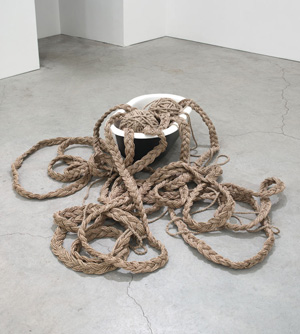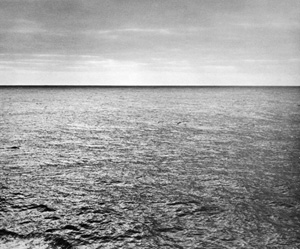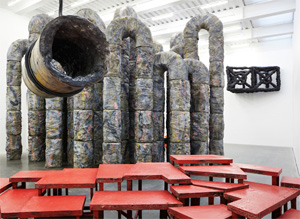Was That Minimalism?
John Haberin New York City
Sheila Hicks, Bill Bollinger, and Phyllida Barlow
What if? Probably everyone asks that about choices not taken, at least once in life, with relief or regret. Looking back a generation or two in art, the same question applies. What if Eva Hesse, Francesca Woodman, or Ana Mendieta had survived? What if any number of artists had not burnt out? What if just as many artists gained the recognition they deserved?
Would art ever since have looked different? Would that generation look different today? Maybe one would have seen a little less irony. Maybe painting would not have ricocheted between formalism and back. Maybe Minimalism would look relevant again—but not necessarily the same. Maybe it would seem more modest or messier, less familiar or more everyday? 
Three shows ask all that, and each promises a rediscovery. Sheila Hicks was born in 1934 and Bill Bollinger in 1939. Phyllida Barlow, born in 1944, is almost a baby by comparison, but then the British were often late in the modern art game. Hicks has worked steadily and is still working, with a top gallery at that, but almost under the radar. Bollinger was briefly and deservedly a star but then almost forgotten. Barlow is having her first museum act in the United States. Together, they supply an alternative model for Minimalism—and a surprisingly familiar one at that.
Rediscoveries are never innocent. Art is a business, with pressure to find the latest thing, past or present. Bollinger's retrospective makes an impact in part by leaving out his more traditional sculpture. Lack of innocence, though, is not the same as guilt. It simply means looking through today's eyes, and these shows match a wave of younger artists at play with Minimalism and household objects—what one shows calls "Everyday Abstract – Abstract Everyday" and I might call Neo-Minimalism. Hicks preserves the movement's clarity but with the materials of craft and design, Bollinger its spareness but as a mark of chaos or even failure, and Barlow its industrial origins.
Weaving Minimalism
Remember Minimalism's hard, industrial edge? For fifty-five years, Sheila Hicks has dedicated herself to one thing, with work of such clarity that one can take it in at a glance. After that, though, things grow complicated, and the more one tries to describe it, the more one has to qualify and to explain. Start with that one thing, weaving. She weaves everything, from materials as simple as linen and as natural as corn husks, not unlike what a movement in France called "Supports/Surfaces." They just may not cover anything.
They may not be able to cover anything, in loose threads barely sufficient to hold other bits together. They may look like an uncovering, like a head of hair—or the thick nap of a comforter without anything to hold it together or to hold it in. They may wind together into something tough and harsh, or that dark hair may consist of something as hard as steel filaments amid lighter linen and cotton. Menhir, completed in 2004, almost sounds like "my hair," even while meaning ancient monuments from the Atlantic coast to either side of the Channel. Hard, soft, or both at once, one can practically feel it.
She studied at Yale with George Kubler, a scholar of pre-Columbian art and art after the Spanish conquest. She is in the design collection of the Cooper-Hewitt and Musée des Arts Décoratifs, in Paris. If she has one constant, though, it is tapestry way too small for blankets even for a child. It may come as a surprise to find one such from 1958. A 2011 retrospective came no closer than the Institute of Contemporary Art, in Philadelphia, even though "women's work" is hot again—but this touches most of those years, with no obvious arc or development. And it is clearly art, except when it is not.
The Met counted her in 2006 among the American Studio Craft Movement, but she has lived since 1964 in Paris. The coarse rope of Overflow from that year spills to the floor from an even coarser washtub, as in a postwar cold-water flat. An old-fashioned key with fat, colorful rubber bands hanging down could allow entrance. She intended her most clearly decorative art, a bas relief as the bottom half of an oval, for an Air France Boeing 747. Then again, Frank Stella was busy at his Protractor Paintings in 1969, too. Not that he would have assembled one from rectangles of varying sizes in no particular order.
She also studied with Josef Albers, known for his Homage to the Square, although one can forget that he had taught design at the Bauhaus. Still, Hicks is not making pure painting or pure anything else, no more than another woman in Minimalism, Rosemarie Castoro. Even her 1973 Masonry, a precise grid of squares, uses its diagonal weave to break sharply with the picture plane. It matters that a 1978 white column extends to the ceiling just inches from an actual gallery column of more or less the same dimensions. It matters, too, though that hers never quite touches the ground, as if floating, and that she assembles it from cotton bands with strings at each corner—maybe diapers or hospital supplies.
She accepts imagery, architecture, and geometry, like the bathtub or column, so long as she can flirt with them all. Her 1974 wool Tapis de Prière (or "prayer rug") looks like the silhouette of a minaret. She uses both natural and found materials, while making it hard to tell them apart. The rope in the bathtub is seagrass, and what look like black shells caught up in thread are slate. Hicks makes art about design and craft, as if weaving Minimalism, but works often as not have loose craft and banal design. Somehow, the materials are enough.
So much depends
It hardly took an Ivy League graduate in aeronautical engineering to work in Minimalism. Bill Bollinger's version, though, has a special rawness, as if he had nothing to prove. He could draw in aluminum pipes and fittings as readily as on paper. Like Jennie C. Jones now, he could simply stretch a cable along the floor or connect them from floor to ceiling—but with the rudeness of Manila rope and clamps rather than the smooth color and unheard music of audio equipment. Bollinger came to New York out of Brown University in 1961. Maybe that made industrial parts and found materials all the more a rebellion.
In place of a 3D grid from Sol LeWitt, he could lean a hunk of chain-link fencing against the wall, the kind that still surrounds any number of New York lots—and it all but blends in as one steps far enough back. In place of the boxes and tiling from Carl Andre, so beautifully prepared and so determined to mark one's path, a 1968 Channel Piece of anodized aluminum could run overhead, its slim horizontal tapering to a trapezoid at one end. At SculptureCenter, one could easily miss it on the way in. A few pieces amount to boards or two-by-fours on sawhorses, like worktables for a project yet to begin. Water seems to have collected of its own accord in rusted drums or a plain pair of wheelbarrows. "so much depends / upon / a red wheel / barrow / glazed with rain / water," or so little, and where are the white chickens?
 His retrospective, curated by Christiane Meyer-Stoll in collaboration with the Kunstmuseum Liechtenstein, amounts to less than four years—ending in January 1970, when he and Bykert Gallery uptown briefly took over a high floor of a modernist landmark in, of all things, present day Chelsea. Bollinger had his first solo show in 1966, at a gallery that a year later exhibited geometric abstraction from Ronnie Landfield alongside two other survivors of what the National Academy has called "High Times, Hard Times," Dan Christensen and Kenneth Showell. He appeared at the center of things in "Anti-Illusion" at the Whitney thanks to Marcia Tucker, in "Nine at Leo Castelli," and in the very opening of Paula Cooper. Still, his marriage was in trouble, and he had his last show at OK Harris in 1974 before heading upstate, with later teaching jobs in Minneapolis and Rhode Island. He kept working fourteen more years, to judge by jagged iron on display only in a West Village gallery, somewhere between congealed lava and the Victory of Samothrace, and a few photographs of gentle abstract paintings. None, though, have survived, and indeed much of the retrospective relies on reconstructions.
His retrospective, curated by Christiane Meyer-Stoll in collaboration with the Kunstmuseum Liechtenstein, amounts to less than four years—ending in January 1970, when he and Bykert Gallery uptown briefly took over a high floor of a modernist landmark in, of all things, present day Chelsea. Bollinger had his first solo show in 1966, at a gallery that a year later exhibited geometric abstraction from Ronnie Landfield alongside two other survivors of what the National Academy has called "High Times, Hard Times," Dan Christensen and Kenneth Showell. He appeared at the center of things in "Anti-Illusion" at the Whitney thanks to Marcia Tucker, in "Nine at Leo Castelli," and in the very opening of Paula Cooper. Still, his marriage was in trouble, and he had his last show at OK Harris in 1974 before heading upstate, with later teaching jobs in Minneapolis and Rhode Island. He kept working fourteen more years, to judge by jagged iron on display only in a West Village gallery, somewhere between congealed lava and the Victory of Samothrace, and a few photographs of gentle abstract paintings. None, though, have survived, and indeed much of the retrospective relies on reconstructions.
Be sure not to tip over either of those wheelbarrows, and be sure not to walk into the most majestic work, again from 1968, the fifty feet of Cyclone Fence. It rises midway like a wave, in a kind of open tent six feet high, before descending again to the floor. Surely an engineer would, unlike Robert Smithson or Richard Tuttle, have thought of entropy not as metaphysics, but a mathematical law and the driving principle of life. And surely an engineer would have seen a sine wave as a bridge between technology and nature. It allows him not to defy gravity or mass, but to pose the terms of art between form and space. The angled pipe drawings also resemble a cryptic alphabet, like anthropological symbols that, Joseph Masheck argues, motivated Ad Reinhardt.
Barnett Newman is supposed to have joked that Minimalism "could not get it up," a complaint that managed to rebound against Abstract Expressionism. It became hard not to see a pack of drunken males led by Jackson Pollock, with drip painting an extension of his prick. Bollinger made fun of the metaphor on video, facing the camera with a pipe between his legs as he works to make it stand on end. Eventually he does, at which point he knocks it over, as ambiguously a casual boast of success or a restoration of failure. Powdered graphite covers a floor in 1969, recalling flung lead and tar by Richard Serra. One can see the spatters low on the wall, though, as not aggression but the bare evidence of materials.
One can see the blackness, too, as a pool of water, and water obsessed him. It fills the hoses and barrels, and echoes in the wave of fencing rising from the floor. He once floated a pipe in the river, and he used a photo from his 1968 Atlantic crossing as a gallery invitation in 1969. Works on paper most often have the texture of spray paint and a horizon line, much as drawings collected by Dan Flavin connect his fluorescent tubes to Hudson River light. Maybe liquid came to stand for something larger than Bollinger himself, in an artist's increasing bitterness. So much depends, and he died with help from alcohol at forty-eight.
Little red schoolhouse
Phyllida Barlow has something she wants to teach you. Some twenty desks, depending on just how one counts their irregular shapes, cluster tightly, like a classroom by Hugh Hayden short of willing students (or, unlike Jeff Landman and his Minimalist archaeology, chairs). They vary in height enough for some overlap, but not enough for stacking, leaving their smooth red tops to slope or stagger down. She calls it Untitled: broken stage, but the cast, too, has departed. It could parody Bauhaus modularity or postmodern performance. Either way, learn your lesson.
Barlow is herself a learning experience for many a New Yorker. The New Museum calls her an influence on British sculpture since the 1960s, when she turned on formal abstraction.  Quite generally, monumentality takes a beating, as with a dark clutter of tall, narrow arches. So do Minimalism's industrial origins, as with crushed cardboard boxes or the dark wood simulacrum of a charred metal drum. Burnt timbers and torn yellow fabric derive from Arte Povera, the mix of hard and soft materials to Eva Hesse. Barlow calls the materials of her stage simply timber, cement, and paint.
Quite generally, monumentality takes a beating, as with a dark clutter of tall, narrow arches. So do Minimalism's industrial origins, as with crushed cardboard boxes or the dark wood simulacrum of a charred metal drum. Burnt timbers and torn yellow fabric derive from Arte Povera, the mix of hard and soft materials to Eva Hesse. Barlow calls the materials of her stage simply timber, cement, and paint.
The museum is taking a break between the 2012 Triennial and summer for solo shows, one to a floor. And her tricky obstacle course goes well with Klara Lidén showing off and Tacita Dean, including Tacita Dean in film, for a respectful look back from England at late Modernism, on video. In the cafeteria, Ellen Altfest brings her dry, meticulous realism and severely cropped compositions to gourds and the male body. They give her tactile but claustrophobic spaces added resonance. Next door, Nathalie Djurberg sets out eighty lurid birds, in real space, to music by Hans Berg. Miss her claymation racism, fairy tales, and porn? The Parade of Rituals and Stereotypes continues on video, on loan from Prada—no doubt making up for Alexander McQueen's raunch at the Met drawing longer lines than its own.
By comparison, Barlow plays the traditionalist after all. Anthony Caro may yet lie behind the stage's mass, scale, and polished red. Hesse's unsettling space between organic and inorganic seems worlds away. So do John Chamberlain and much of Minimalism, with popular and industrial culture mingling at their edges and filled with light. Objects and images alike lose their associations coming in. Blackness set against bright colors helps enforce the divisions between hard and soft. Only the rounded arches tempt one to touch.
The museum offers neither a temptation nor a retrospective. Its handful of works all date from 2012. The museum calls them site specific, but they bow to the site only in finding room. The drum, say, descends just far enough to remain overhead, and Untitled: 21 Arches rises just high enough to miss the ceiling. Where Minimalism invited love and hatred by demanding that one enter,"Siege" approaches an installation only by barring one's movements through space. It looks remote even up close and static even while threatening to land on your head.
Barlow embraces the big-box architecture. The installation that I have called desks almost resembles Vlatka Horvat's bedframes. But not quite, for one steps through those, just as they step through one another, and one can imagine them at home. Barlow, in contrast, keeps her distance. Maybe that is why I loved the work for its emptiness and object lessons. Maybe it is also why, as a lifelong learner, I kept searching for something out of my own past, like a desk.

Sheila Hicks ran at Sikkema Jenkins through May 25, 2012, Bill Bollinger at SculptureCenter through July 30 and at Algus Greenspon through June 9, Phyllida Barlow at the New Museum through June 24, and Vlatka Horvat at Rachel Uffner though June 24. The review of Bollinger first appeared in Artillery magazine in a somewhat different form. A related review picks up Phyllida Barlow a few months later with a memorable exhibition.




